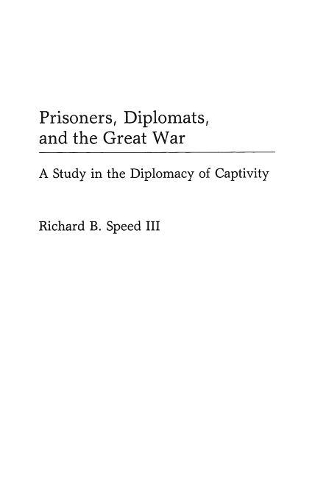
Prisoners, Diplomats, and the Great War: A Study in the Diplomacy of Captivity
(Hardback)
Publishing Details
Prisoners, Diplomats, and the Great War: A Study in the Diplomacy of Captivity
By (Author) Richard Speed
Bloomsbury Publishing PLC
Praeger Publishers Inc
15th June 1990
United States
Classifications
Tertiary Education
Non Fiction
Diplomacy
940.472
Physical Properties
Hardback
256
Description
Military and civilian captivity practices by four major European powers and the United States during World War I are surveyed in this book. Speed argues that while the pressures of total war, as they emerged during the conflict, drove the belligerents to violate many of the norms of war, they attempted to behave in accordance with a liberal tradition of captivity which held that prisoners of war were merely men whom nobody had a right to harm. Aside from a few journal articles that deal with small aspects of the topic, there is no other scholarly work that focuses on captivity during the First World War. Speed makes extensive use of rarely cited American diplomatic records in order to offer a more objective view of camp conditions. A special feature is the depiction of American camps in France drawn from previously uncited War Department records. The book explores the radical tradition of captivity that emerged in the Soviet Union. This tradition held that the prisoner was not merely a man for whom the war was over, but that he was a potential recruit in the class war whose national loyalty could be subverted in the interest of the ideological conflict. Thus, while the Western world entered the war with a single tradition of captivity, it emerged from the conflict with two antithetical traditions. While the United States and Western Europe in general have clung to the liberal tradition, third world revolutionary states like Vietnam and North Korea have embraced the radical tradition. This book is essential reading for all scholars and students of modern European/American diplomatic and military history. Government officials involved with hostages or prisoners of war will also find much of value here.
Reviews
Speed's excellent book provides a skeletal structure for a modestly maturing but hitherto formless body of historical literature on prisoners of war (POWs) during WWI. In the process, Speed supports a view of that conflict more sophisticated than all-or-nothing total war.' In spite of its unprecendented scale of brutality and destruction, WWI did have some limits based on the mutual restraints and common interests of otherwise bitter enemies. Treatment of millions of POWs was a major item of indirect, reciprocal negotiations among foes. Speed compares the UK, Germany, France, and Russia (and US in France) regarding methods and standards of POW care and the indirect diplomacy used in dealing with them. He also considers civilian internees or "alien enemies" in the US, Germany, and the UK. Clear description and comparative analysis are strengths; casual readers will miss the usual anecdotes and escape stories. They may also feel the need of historical background. Serious students will see that the documentation is strong, especially from the American perspective. Internment of enemy aliens in the US is treated charitably, as levels of discomfort and mortality were comparatively low. High mortality in Russia is ascribed to inefficiency and overwhelming numbers, although more stress on viciousness in every country would not be unrealistic. College, university, and public libraries.-Choice
"Speed's excellent book provides a skeletal structure for a modestly maturing but hitherto formless body of historical literature on prisoners of war (POWs) during WWI. In the process, Speed supports a view of that conflict more sophisticated than all-or-nothing total war.' In spite of its unprecendented scale of brutality and destruction, WWI did have some limits based on the mutual restraints and common interests of otherwise bitter enemies. Treatment of millions of POWs was a major item of indirect, reciprocal negotiations among foes. Speed compares the UK, Germany, France, and Russia (and US in France) regarding methods and standards of POW care and the indirect diplomacy used in dealing with them. He also considers civilian internees or "alien enemies" in the US, Germany, and the UK. Clear description and comparative analysis are strengths; casual readers will miss the usual anecdotes and escape stories. They may also feel the need of historical background. Serious students will see that the documentation is strong, especially from the American perspective. Internment of enemy aliens in the US is treated charitably, as levels of discomfort and mortality were comparatively low. High mortality in Russia is ascribed to inefficiency and overwhelming numbers, although more stress on viciousness in every country would not be unrealistic. College, university, and public libraries."-Choice
Author Bio
RICHARD B. SPEED, III is Lecturer, Department of History at California State University at Hayward.
